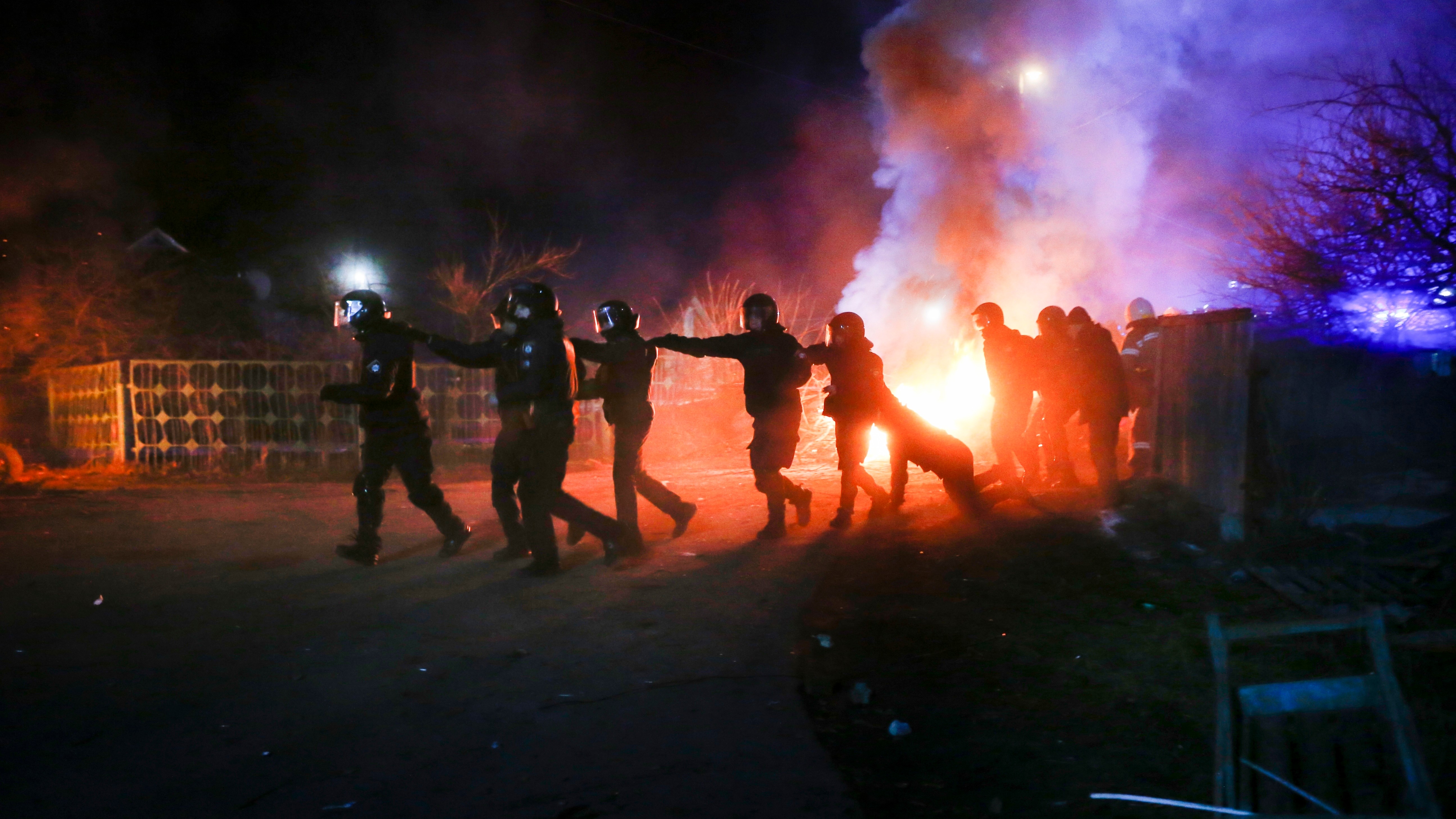An Oakland homeless encampment in 2019. Photo by Michael Short/Bloomberg via Getty
On a windy morning in January, a group of police and city workers closed a long-existing tent encampment beneath an overpass on K Street in Washington, D.C.First came the warning posted to the camp about the imminent sweep—generally, camp inhabitants are given three days to pack up their belongings and leave. Then came the removal of property from the sidewalk, as Department of Public Works employees dragged trash and tents and other personal belongings into the back of an idling garbage truck.“It’s not usually 4 a.m., it’s usually 2 a.m. [when the sweep happens],” a man named Adam Bredenberg who lived in an encampment told me before a similar eviction in 2017 in the Bay Area. “I pound an energy drink, put on some warm clothes, get my essential stuff. They basically force all the people out of the space, then usually they put down fences and clean everything out, and the people end up on the edge of whatever space they've cleared out trying to decide where to go. In a couple cases, there have been citations and arrests and brutality.”This process is routine in many cities with large homeless populations, generally the result of property owners lodging enough complaints to stir the municipality into action. After the K Street sweep was over, out came the advocates and reporters asking the obvious question: Where should these people go?“There is a [shelter] bed available to everyone on the street experiencing homelessness,” Wayne Turnage, the city’s deputy mayor for health and human services, told the Washington Post. This response by an official is extremely common. It suggests that a choice is being made by these homeless folks: Do you want to go into a shelter or do you want your stuff swept?But a closer look at the choice between remaining on the street in an encampment and going to a shelter shows that it's not an easy decision for many homeless people—and some of them don't have any options at all.San Francisco currently has a list of around 1,000 people waiting for a 90-day shelter bed. In Portsmouth, New Hampshire, the waitlist was 163 people deep last December. Last summer in Greenfield, Massachusetts, 25 people waited for one of the 20 beds available. In many cities, there aren't enough shelter beds to accommodate the people living on the streets. They aren't living in tents by choice, but out of necessity.Word about the shelter waitlists get around, and so even if a city can offer some extra temporary shelter for encampment residents, the perception is still that their entry into a shelter bed will push someone else back onto the street. I’ve spoken to dozens of people experiencing homelessness over the years, and many have told me that in that case, they’d rather just stay outside.But even when there are shelter beds available, there are still plenty of logical reasons that someone may decide not to enter the system, and many policies that keep them outside of it.As codified in the Callahan Consent Decree from 1981, New York City is legally obligated to provide shelter to any homeless individual. (Most other cities do not have the same obligation.) However, there are rules in those shelters, including a curfew, which makes sense if you believe that homeless people need structure and order to their lives. But that's certainly not what all of them need—many, for instance, have jobs that might keep them out past the shelter curfew.There are other rules that are simply non-starters for other people. “In Oakland, there are 460 shelter beds total available for over 9,000 unsheltered people on any given night,” encampment resident Yana Johnson said in the days leading up to an eviction in 2018. “These 460 shelter beds do not serve women with children, people with pets, or any working person who has night shifts. Under this criteria, a majority of residents… are totally excluded from shelters, which are often only available for one night.”Some cities have been trying to remove these barriers, but it’s a slow process despite the best efforts of local homeless activists. In Denver, there have recently been attempts by lawmakers to create a homeless bill of rights. “It can’t just be a building. It has to be a place where people can live out their basic life functions,” legislator Jovan Melton, author of the bill, told the Denver Post. “Say you’re working a swing shift, but the shelter says we stop taking people at 5 p.m. Well, that’s not adequate. That doesn’t meet that person’s needs.”And if those needs aren’t being met, the logical choice for many people experiencing homelessness will be to remain outside of the shelter system.“[Living outside] amongst other people, there’s a sense of community,” Amber Whitson, a Bay Area resident who’s been living “on the streets,” as she described it, for almost 23 years, told me. “If alone, solitude. If out in nature, then to be away from society. If in town, then to have easier access to the things that I might need. There are many challenges that come along with living in a tent, but in the right circumstances, those challenges are worth it.” Some shelter stays are for one night at a time, forcing people to leave when the sun comes up. Other shelters allow stays for longer periods, generally maxing out at around 90 days. But these spaces never provide a space you can truly call your own. Even though a street encampment is in constant danger of being swept, it makes sense someone would choose a static spot to keep one’s belongings within a community they can trust to watch over things when they leave.Which isn’t to say that encampments are some utopian ideal—there’s plenty of danger coming from every direction, from people who are also living outside, to housed people upset at homelessness, to cars and trucks speeding past. But at least they don't have to deal with shelter employees who have a huge amount of power over them.During the infamous 2013 eviction of the Bay Area’s Albany Bulb encampment, Whitson said that she attempted to enter the shelter that was erected nearby to house some of the homeless folks being driven out. “I was greeted at the door by a woman holding a Maglite over her head, as if to strike someone with it, and was turned away after I was told that I wasn’t on the list,” Whitson tells me. “That was my last attempt at staying in a shelter.”As Andrew Huff wrote in the Philadelphia-based social platform Generocity:
Some shelter stays are for one night at a time, forcing people to leave when the sun comes up. Other shelters allow stays for longer periods, generally maxing out at around 90 days. But these spaces never provide a space you can truly call your own. Even though a street encampment is in constant danger of being swept, it makes sense someone would choose a static spot to keep one’s belongings within a community they can trust to watch over things when they leave.Which isn’t to say that encampments are some utopian ideal—there’s plenty of danger coming from every direction, from people who are also living outside, to housed people upset at homelessness, to cars and trucks speeding past. But at least they don't have to deal with shelter employees who have a huge amount of power over them.During the infamous 2013 eviction of the Bay Area’s Albany Bulb encampment, Whitson said that she attempted to enter the shelter that was erected nearby to house some of the homeless folks being driven out. “I was greeted at the door by a woman holding a Maglite over her head, as if to strike someone with it, and was turned away after I was told that I wasn’t on the list,” Whitson tells me. “That was my last attempt at staying in a shelter.”As Andrew Huff wrote in the Philadelphia-based social platform Generocity:
Advertisement
Advertisement
Shelter beds are often in extremely short supply
Shelters don’t always fit people’s lives
Advertisement

Shelters aren’t stable
Advertisement
Reports of sexual abuse in shelters are rampant, and it’s the result of this inherent dynamic between provider and recipient. Sometimes, the overworked and underpaid staff can’t or aren’t willing to give shelter residents the care they need. This forces residents to take matters into their own hands.“We had a woman living with us who was getting increasingly hostile and violent, and we warned staff multiple times. They ignored us, so we had to hide all the knives and anything that could be used as a weapon,” said Esperanza Fonseca, who was homeless in Orange County, California, in 2018. “This woman ended up physically attacking me at six in the morning, but since staff was so unresponsive, the women in the house defended me and subdued her.”Police eventually came, and Fonseca’s attacker ended up back on the street. Soon after, so did the women who ended up defending Fonseca. The staff, Fonseca said, had claimed these women were violent. Without a support network in place, Fonseca packed up and left.“The most painful thing was to watch women leave the shelter to go back to the streets because they thought it was better,” Fonseca said. “In the shelter, I was subjected to violence, threats, harassment, discrimination. That is what we feared we would face in the streets, but we still experienced it at the shelter, just with more rules and expired milk.”Sign up for our newsletter to get the best of VICE delivered to your inbox daily.Follow Rick Paulas on Twitter.As an emergency shelter staff-member, I have been given the power to bring someone inside off the streets or send him right back — more or less at my discretion. And I’m not the only one with that power. There is no legal right to shelter in Philadelphia — which means those of us who can grant you access to shelter can also withhold it, restrict it, or take it away.
